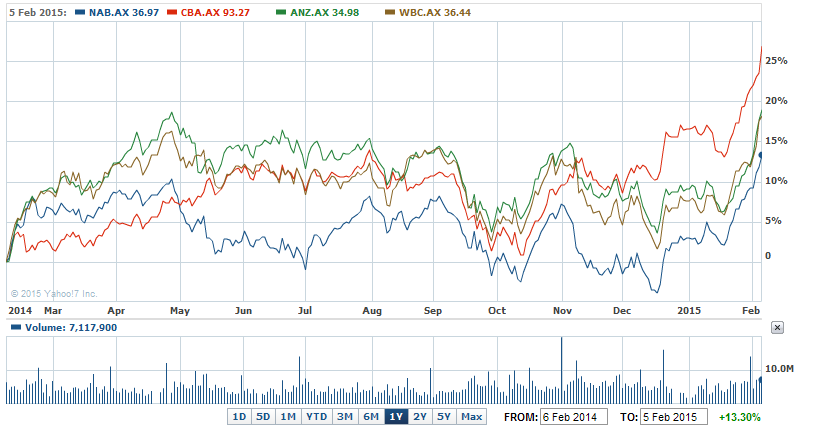National Australia Bank (NAB) shareholders weren’t all that convinced, but the rest of the sector was by the first quarter trading update.
As a result, analysts are now awaiting the Commonwealth Bank’s (CBA) interim profit next Wednesday to get a good guide on the outlook for the most important sector for the health of the Australian market.
But judging by the price surge in CBA shares yesterday as they jumped to close well over $93 (an all time high of $93.27), the market is already banking a solid profit rise and higher dividend from the industry leader next week..
ANZ and Westpac (WBC) also hit new record highs, gaining 1% to $34.98 and 0.6% to $36.44 respectively.
But the shares lost ground as the day went on and the shares ended up 2.3% at $36.97.
By contrast the Commonwealth’s shares were up more than 2%, or $2.48 at $93.27. The bank’s gains accelerated in the afternoon.
The CBA now has a market capitalisation of more than $150 billion.
Banks continue to reach record highs

The NAB reported unaudited cash earnings of $1.65 billion for the December quarter, up 6% on the first quarter of 2013-14. Earnings were in line with market forecasts.
And on a statutory basis, unaudited net profit attributable for the December quarter was approximately $1.80 billion. NAB said the main difference between statutory and cash earnings relates to fair value and hedge ineffectiveness, elimination of treasury shares and distributions.
Revenue rose 2% after gains from the sale of commercial real estate assets in the UK are eliminated.
NAB shares were up more than 1% in early trading after the update was released before trading.
NAB said in the statement to the ASX that intense competition in business lending has depressed its net interest margin over the quarter (NAB is the country’s biggest lender to business with a 28% share of the market). Offsetting that margin compression was a boost in lending volumes in the quarter.
NAB chief executive Andrew Thorburn described the result as “solid". He said in the statement progress was being made on re-orientating the bank towards its domestic franchise as it tries to quit its costly banking adventure in Britain.
The NAB said an increase in cash earnings in its Australian banking business was driven by stronger markets income, growth in mortgage lending and those higher business lending volumes.
But this was "partially offset by a lower NIM [net interest margin] primarily relating to business lending competition”, he said.
The bank said its group net interest margin was flat, but excluding its markets and treasury operations had come in “slightly lower”, without revealing the actual margins.
"While the improvement in our core business banking franchise will take time, volume growth is now around [average] and we are well advanced on the hiring of additional business bankers. However, we continue to see intense competition for business lending,” Mr Thorburn said in yesterday’s statement.
NAB’s growth was led by loans to investors, which grew at 12.4% – twice its growth in loans to owner occupiers and more than 2% above the 10% that APRA imposed late last year as part of its new “macroprudential” policy.
Mr Thorburn said asset quality had improved (that’s because of the record low interest rates). The closely watched bad and doubtful debts figure was up 30% over the quarter but the bank said bad debts were stable before accounting adjustments.
"Further significant improvements in asset quality over the quarter are pleasing and reflect both the benign operating environment and the initiatives undertaken over recent years to improve our risk profile," Mr Thorburn said.
NAB will report its first half profit on May 7.
The CBA’s report next Wednesday will set the tone – the NAB and its March 31 balancing rivals in Westpac and the ANZ will be in catch up mode, unless there’s a shake out in the meantime.













